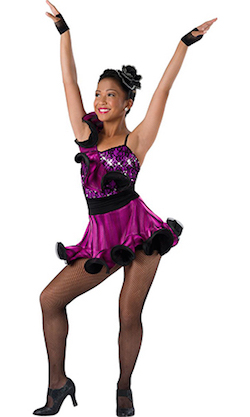Fierce, sassy, fabulous, and genuine. Those are the first four words that come to mind when I think of up and coming dancer/teacher Meghan Sanett. With a recent nomination for an Industry Dance Award, and touring as a faculty member with Tremaine Dance Conventions, Meghan Sanett is definitely making a [ball change] splash in the dance world.
Dance Informa had the honor of interviewing Ms. Sanett about teaching for conventions, her challenges in the dance world, and the importance of social media in her dance career.

Meghan Sanett. Photo by Hollywood Dance Shoot, Cody Green and Kylie Shea.
Tell me a bit about your dance background.
“I started dancing when I was three years old out in Southern California. I trained for many years by just taking various classes at The Edge in Hollywood and Millennium in North Hollywood. (Big shout-out to my Mom for being my personal taxi driver). When I was 13, Keri LaGrand told me about the Tremaine Performance Company so I auditioned and I have been with Joe and the incredible variety of teachers who have made up his faculty for the last 12 years.”
With whom are you currently working?
“Currently I’m touring as a faculty member with Tremaine Dance Conventions!”
What do you love most about teaching at conventions?
“I love being able to be a positive influence to this next generation of dancers. I feel like there are so many negative people that kids today are latching on to and I just want to let them know you can achieve your goals, be a positive person, and most importantly be yourself even if you’re different, unique, or just straight up weird! I’m all about being different and making kids realize that that’s absolutely okay.”
Do you think social media has helped your career, and if so, how?
“Oh, it definitely has! I’m so thankful for it! As dancers we have very limited ways of really getting our name out there in terms of being noticed as your own brand. What social media has done for me has been incredible. It’s given me a voice…a platform to the public that I never knew was possible! I’ve always posted my choreography on YouTube since I started high school. When I was in high school, social media wasn’t a huge thing. I didn’t post videos in order to get views or likes or hope to become instantly famous, I put them up to just share with friends and I constantly asked for feedback from teachers. I would email the links to my dance inspirations, and I would just try to better myself. That’s always my goal. Never to stay the same, always keep growing, always keep challenging your mind.”
How did it feel to be nominated for an Industry Dance Award?
“Holy moly! I was so insanely shocked. I performed in the IDA’s last year and the event was so wonderful and glamorous. I felt so honored to be there because Joe Tremaine won the Dance Legend of the Year award and my fellow Tremaine faculty member Derrick Schrader won Favorite Convention Teacher of the Year! So when I found out I was nominated after only teaching on convention for one year, I practically fell off my chair in the airport. To be recognized for something I have dreamt of doing since I was little still blows my mind. Also, to be in the same category as one of my personal heroes Brian Friedman, the incredible diva herself, Tricia Miranda, and my fellow faculty member (AND WINNER OF THE AWARD THIS YEAR!!) Ms. Laurie Johnson who I took classes from when I attended Tremaine Conventions, was just such an honor in itself.”

Meghan Sanett teaching at Tremaine Dance Conventions in Los Angeles in April 2015. Photo by Susan Sanett.
What is your favorite style of dance to teach?
“I love teaching either sassy jazz or really aggressive contemporary. I love sassy jazz because I get to incorporate not just dance steps but also lessons about confidence. This generation has some serious self esteem issues and just overthinking EVERYTHING and I love to be the person to instill that Beyoncé fierce confidence and let them know that it’s okay to come out of your shell and just LIVE! And I love teaching aggressive contemporary because I am a huge fan of musicality and being super athletic. I was always taught that girls should be able to do everything boys can do, so when I get a chance to give ladies some hard choreography that makes them absolutely beastly, I just am a consistent smiling weirdo throughout the entire class. I love seeing people go past their comfort zones and accomplishing steps and movements they never knew they could do!”
What are some challenges you face in the dance world?
“There are so many challenges! To name a few… Keeping yourself healthy and feeling and looking good because at the end of the day your body is your product. You are selling your look just as much as your talent. Weight was an issue with me when I was younger, I always was the heavier girl in my dance classes growing up but it just really inspired me to keep working and pushing even if I didn’t look like everyone else. I’m so glad I did because being different and unique is one of my favorite things about myself whether it’s personality or body shape. And now that I have the courage to admit that, it speaks volumes about how far I’ve come in terms of confidence. So cool!”

Meghan Sanett. Photo by Meghan Sanett (iPhone timers are magical).
What does a ‘day in the life’ of Meghan Sanett look like?
“Oh boy. Well a day in the life of Meghan Sanett Los Angeles edition always consists of getting coffee in the morning…otherwise I don’t function. That sometimes involves my two best friends and me going to breakfast once a week. It’s our thing. You have to have those friends to turn to so your life makes sense! Then going to the gym (if I’m feeling the muscle vibes), teaching class or taking class depending on what day it is, browsing through social media to see what’s happening, and if I have the time I’ll go into a studio and improv my life away. Usually that turns into staying for 3-4 hours without me realizing. Then I head back home to my apartment in North Hollywood, have a glass of wine, and chill. I am a total homebody. I’d much rather be home in sweats and embarrassing fuzzy socks then out and about.
THEN, if it’s a Day In The Life of Meghan Sanett Travel Day edition, I usually won’t sleep the night before, I’ll go to LAX super early (I call LAX my boyfriend since I see it so often) and grab breakfast from the same place in the American Airlines terminal. (They know who I am now). I’ll board a flight to go choreograph and teach at studios across the country. If it’s during the year I’ll board a flight with my Tremaine faculty friends and end up in a beautiful city for a full out weekend of dancing, teaching, judging competitions, and performing. And as a personal tradition, after I land at LAX, I always drive back home on Pacific Coast Highway to see the ocean. It’s a total stress reliever and it just reminds me how much I love California.”
What is some advice you have for dancers wanting to break in to the world of professional dance or conventions?
“Don’t compromise who you are in order to book jobs. Become the working dancer you want to be by staying true to yourself. If people ask you to do things you’re not comfortable with, don’t do it. You have the power to create the career you want. I’ll just say…being genuinely kind, having loyalty and hard work goes a long way. A loooooong way.”
Where do you see yourself in 10 years?
“Oooh that’s a good question. I see myself being married to some really attractive, amazing, creative, funny man that I’ll be so happy with, maybe with a cute little dancer or sports fan crawling around the house. Industry wise, I see myself choreographing for either television, film, or Broadway shows. I, of course, still want to be involved in the performing aspect of the industry so acting or work like that would still be fun. I definitely want to live in California but if I also had a place in NYC, I would not be mad about it. I just want to be healthy, doing what I love and am passionate about, being surrounded by supportive, loving people, traveling like crazy, and having a great time in this crazy thing we call life.”
By Allison Gupton of Dance Informa.
Photo (top): Meghan Sanett on the Industry Dance Awards red carpet in August 2015. Photo courtesy of the Industry Dance Awards.
The post Fierce and Genuine: Convention Teacher Meghan Sanett appeared first on Dance Informa Magazine.
 First up, download this free Weekly Studio Planner. Next, each Sunday evening or Monday morning, sit down and answer the questions below to set your goals for the week in each category:
First up, download this free Weekly Studio Planner. Next, each Sunday evening or Monday morning, sit down and answer the questions below to set your goals for the week in each category:








